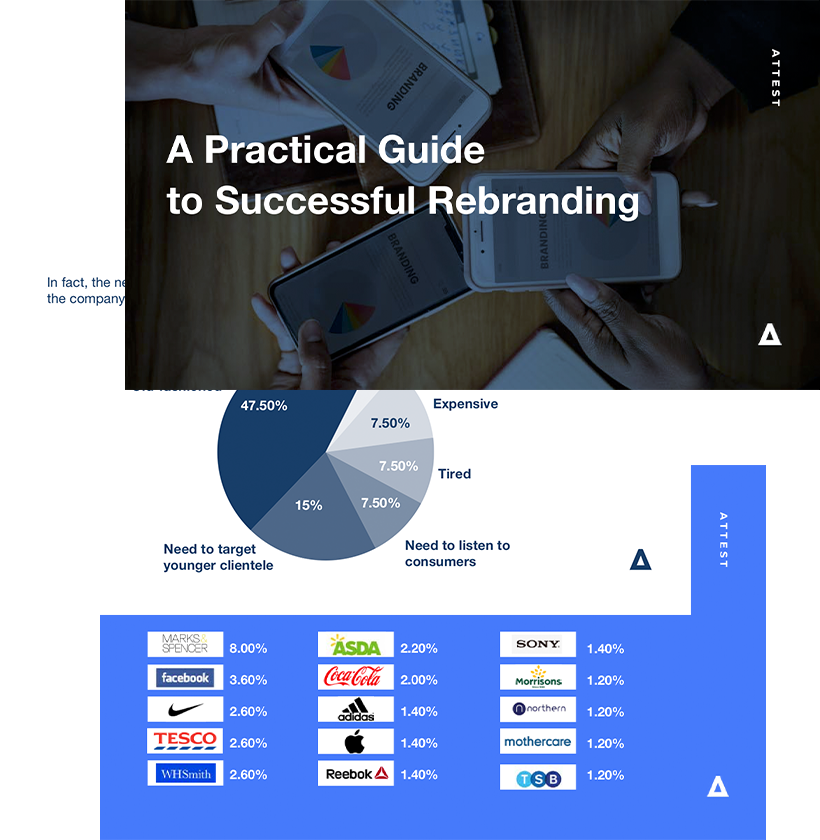10 Ways To Understand and Shift Your Brand Perception in 2018

A practical guide for leaders that want to understand their brand perception and how to affect positive change for the future.
Think you know what your brand represents? I’ll let you in on a little secret; it’s not what you say in your slogan, brand values or advertisements. It’s whatever consumers say you are.
Regardless of the message you transmit, if it’s not received by the audience, it’s null and void.
Brand perception is how consumers view your brand and, although it can be influenced by you, it’s not always easy to do. Where you see a ‘6’, they may well see a ‘9’.
The first hurdle is to actually understand your current brand perception – know what views and beliefs people hold about your brand so you can identify any that need to be realigned with your own. Then it’s time to create a strategy for communicating what you want to be heard and changing opinions.
In this article, we’ll help you do both; examining different ways of measuring brand perception, and shifting it.
Why is Brand Perception Important?
Your brand’s reputation influences everything from the type of customer who will buy it, to how much they will pay and what retailers will stock it (if it’s a physical product). It can have a massive impact on the success of your business.
Let’s say, for example, people start to perceive your brand as low quality after a badly handled product recall; that message will quickly spread via word of mouth and you will rapidly lose market share.
Or perhaps it’s something which occurs more gradually? Sales are declining and you realise it’s because your brand is starting to be viewed as old fashioned among younger consumers. This is incredibly common for legacy brands that don’t change with the times.
A good example is the men’s toiletry brand Old Spice, which young men had come to associate with their granddads. To reinvigorate the brand for a new generation, Old Spice worked with NFL Player Isaiah Mustafa, (aka the Old Spice Guy) on a series of commercials ostensibly aimed at women. The ads aimed to portray Old Spice as something seductive and alluring; a scent that women should want their men to smell of. The campaign was successful by every metric.
Now let’s take a look at McDonald’s; following the publication of books like ‘Fast Food Nation’ and ‘Chew on This’ the brand took a battering. Were their nuggets really made up of beaks, feet and slime? This kind of bad PR can be the death knell for a food brand, so McDonald’s had to act quickly.
Rather than gloss over the allegations, they decided to tackle them head on. They cleaned up their act, made sure the meat in McNuggets were 100% chicken breast and launched the ‘What Makes McDonald’s?’ campaign to promote the authenticity and provenance of its food in order to reassure parents. McDonald’s is now once again the darling of Wall Street.
The reassuring takeaway here is that even if your brand image is failing, it is possible to turn things around. So, don’t be afraid to delve into your brand perception; whatever nasties you find lurking in the closet, you can get your Marigolds on and clean them out!
Measuring Brand Perception
Are you a unique challenger brand? Want to know what consumers think of you? Then ask them – but don’t just ask your own existing customers. Although their opinions are vital, they’re already buying from you. To get a complete picture, you also need to understand what’s stopping others from doing so. Attest can help you obtain consumer insights from across your target market. Here’s who to ask and what:
Ask long-term customers
Your loyal customers make a good place to start because they will give you an understanding of who is buying your brand as well as why. You might find your customers are not who you thought they were. When Old Spice conducted research prior to their rebrand, they would have discovered their customer profile had aged along with their product.
As such, as well as probing consumers about their feelings towards your brand, you should be sure to obtain comprehensive demographic data (Attest includes details on gender, age, home and work region, employment status and sector, nationality, earnings, education level, relationship status, parental status, household income, home ownership, pet ownership and more).
Questions to ask include, ‘Why do you keep buying x brand?’ and ‘What do you love about us?’ You can also ask specific questions to test the efficacy of your own stated qualities i.e. ‘Do you perceive us as being at the cutting edge of kitchen appliances technology?’ or, ‘Do you think we care about the environment?’. Another way would be to provide a list of qualities and ask them to pick the ones they think apply to your brand.
Use a combination of quantitative and qualitative responses (i.e. ‘yes’ and ‘no’ answers and free text) so you can quickly assess overall sentiment but also hear your customers’ thoughts in their own language. A really valuable free text question would be: ‘‘How would you describe us to friends?’. This enables you to pick out the key words and themes your customers associate with your brand, without leading them.
Furthermore, you can test their willingness to recommend you to others with the Net Promoter Score (NPS). Simply ask them how likely they would be to recommend your brand on a scale of 1-10. The resulting percentage can quickly illustrate how much brand loyalty you really have.
2. Ask new customers
New customers offer interesting insights because they are not buying through force of habit or due to long-held beliefs about your brand. These are consumers deciding to give you a go, and you should try to find out why. Has your recent advertising campaign made a positive impact? Did they see your product on sale? Were they recommended by a friend? Or maybe your closest competitor has let customers down in some way and now they’re looking for alternatives?
Ask questions like: ‘Why did you buy?’, ‘What made our brand stand out?’, ‘Why have you not tried us before?’, ‘What almost made you not buy?’. Understanding their first impressions of your brand can help you view it with fresh eyes.
You might also be surprised that the reasons your newest customers are buying your product or service are actually different to your long-time loyal customer base, which can then help you shape a more targeted communications strategy to keep both groups happy.
3. Ask recently lost customers
Breaking up is hard to do; no one wants to hear painful truths and criticisms from an ex, least of all the manager of a carefully crafted brand image. But if you don’t, you’re missing an opportunity for self improvement and growth.
Questions to ask include: ‘Why did you leave?’, ‘How could we win you back?’ and ‘Which brand(s) have you moved to?’ Identifying the brands you’re competing against enables you to look more closely at their image and how they’re communicating it. Research their advertising campaigns and social media activity and you’ll be able to find ideas you can replicate.
4. Ask non-customers
A crucial part of speaking to non-customers is to quantify brand recognition as well as brand perception. After all, there’s no good asking people what they think of you if they’ve actually never heard of you. As such, you’ll want to start by qualifying that they’re aware of your brand/product. If a large percentage are not, that signals a big opportunity for growth through a brand awareness campaign.
Although it might seem disappointing that your brand is unknown, it’s not a bad place to be, since it’s easier to influence opinion of something new than it is to change entrenched beliefs (research shows negative beliefs about a brand usually come about as a result of purchase behaviour not in advance of purchase).
For those consumers who are aware of your brand but chose not to purchase, you should investigate the factors deterring them. Ask, ‘What do you think about our brand?’, ‘What qualities do you associate with it?’, ‘What brands do you purchase instead and why?’. All this will help you understand where you’re getting your messaging wrong.
5. Use social media to get a sense of sentiment
In addition to asking consumers directly, you can also get a glimpse of what they’re saying about your brand on social media. Use social listening tools to see all the mentions your brand has received online. You can get an overview in order to quickly assess the levels of positive vs. negative sentiment and track how your brand mentions have changed over time.
Take a deeper dive and read the comments to see what people are actually saying about you. Maybe they love your recent promotion or perhaps they think your customer service sucks? Whatever it might be, you need to know, because others are reading this opinion and being influenced.
However, remember that social media only ever represents a very small sliver of consumer sentiment, and often only from those biased to influence the brand (via being very complimentary or critical). Learn more about the limits of social media listening in our major report on Brand Intelligence in the Age of Dark Social and Bad Data.
A study by Nielsen shows that for 77% of consumers, the advice of family and friends is the most persuasive when looking for information about new products. The importance of word-of-mouth marketing cannot be underestimated and is why monitoring your brand perception is essential.
How to Shift Brand Perception
Changing public opinion might seem like a difficult task if you can’t afford to hire a big PR firm and throw millions into television advertising, but small efforts can add up to a big change. Follow these five steps to generate some clever ideas in-house and put them into practice.
1. Take inspiration from competitors
Looking at what your closest competitor is doing to effectively promote themselves can provide you with lots of ideas, especially since they are likely to be working similar resources (as opposed to trying to imitate a mega brand).
Using Attest, you can question consumers to find out which brands are making an impact on them, the messages which resonate the most and how they’re receiving those messages. For example, perhaps you discover that your competitors’ customers love what they do on their YouTube channel or the way they work with influencers.
You can also use competitor tracking tools to keep tabs on content your rivals are producing and see how successful it’s being i.e. if your competitor is publishing really popular how-to blog posts that are getting loads of social shares, why not try something similar yourself? You can even use these tools to target relevant influencers who can help spread your messages.
2. Have an internal brainstorm
Once you’ve compiled all the data from your research, it’s time to get to work on your brand strategy. Analyse the responses you’ve received to clearly set out your strengths and weaknesses. If it’s a case of having strong in-house brand values and culture but these not translating to the wider world, then brainstorm ideas for communicating them.
Following your consumer research, you should have a far better idea of what makes customers tick, helping you to develop messaging that will resonate. You can then test your creative concepts with consumers before investing large sums on promotion, to see how effective they’re likely to be.
If, on the other hand, you don’t have a clearly defined brand image to start with, then you need to work at identifying what you stand for. This might include a complete rebranding to make sure you have an identity that is recognisable and consistent throughout your operations. Don’t forget you can also consumer test things like logos, slogans and branding before making the change.
3. Make it a priority
In order to shift perceptions of your brand, you will need to make a commitment – it won’t happen by itself and it won’t happen overnight. The best way to ensure that things get actioned after the research and brainstorming is to make individuals responsible for it.
Create a brand perception task force or give the role exclusively to one person. This way there will be direct accountability and no confusion over who needs to make things happen. Be sure that the people or person tasked with improving brand perception have the necessary time, support and resources to do the job.
It might mean taking employees away from other work, but affecting these changes will underpin your long term brand health and profitability, so it’s worth making sacrifices for.
4. Set SMART goals
Make an action plan detailing each initiative you’ve come up with and draw up a timeframe for delivery. Set overall goals, but make them specific i.e. don’t just say ‘I want better brand perception’, break this down into exact targets like, ‘I want a 20% increase in consumers identifying our brand as fun/cool/high quality’.
Use the SMART structure to help you do this.
If you set smaller goals that feed into your main goal, you stand a greater chance of achieving them. What’s more, consistently making progress will be a great motivator for you and your team.
5. Measure your brand perception regularly
To know if you’re meeting your goals, you’ll need to keep measuring consumer perception of your brand. Attest’s Brand Intelligence gives you a clear, comprehensive snapshot of your current brands strengths, weaknesses, opportunities and strengths. Because it’s easily repeatable, the surveys can be deployed at any time, offering you the ability to benchmark your progress.
Once you hit your targets, don’t stop focusing on brand perception. Unfortunately, it’s a moveable feast and can change, even if you don’t. For example, sentiment towards your brand could change as trends come and go – suddenly you find yourself no longer as relevant as you once were.
Stay close to your customers, and consumers in general, through regular outreach and ensure you don’t get left behind.
In Conclusion
Remember, brand perception is owned by consumers, not brands. When you listen to what people are saying, you can better understand what you need to do in order for your own messages to be heard.
It’s not just about broadcasting loudly; brands need to open a two-way dialogue, understanding the needs and motivations of different customer subsets. Once in possession of that insight, you can devise strategic methods for shifting brand perception amongst them.
This in turn leads to your brand becoming more highly regarded and well-loved. You build brand equity and all areas of your business benefit. Make understanding your brand perception a priority in 2018.
Tell us what you think of this article by leaving a comment on LinkedIn.
Or share it on:

